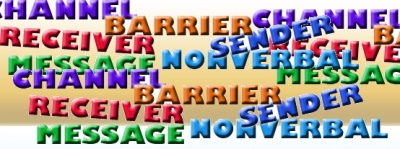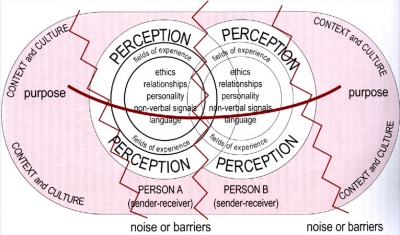Foundation Exemplars/Introduction to Communication Theory
AIMS:
To enable students to develop an understanding of the process of communication and how this process can be illustrated using a model and to develop a working knowledge of the basic terms in communication theory.
OUTCOMES:
•Develop a critical awareness of the process of communication
•Identify key elements of the interactional model of communication
•Use the key vocabulary terms in communication theory correctly
MATERIALS/RESOURCES:
•Communication Theory Quiz
- (3 questions based on h/wk reading (Chase et al., 1995), a model of the communication process without labels, terms without definitions}
•Large labels of the key terms
•Work on BlackBoard, including a labelled diagram (Chase et al., 1995) & a PowerPoint (Vandeveer et al., 2006)
INSTRUCTIONAL PROCEDURES:
•Check of answers to h/wk questions
•Roleplay a communication event – 2 students discuss the weekend
•Students match labels to the real situation & the labels are “stuck” in place
•Meanings of terms on labels are further discussed
•In pairs, students discuss the diagram & attach labels to the “model”
•Model discussed – students can compare their labels to the labelled diagram on eMIT – make sure students acknowledge the model is not always the best answer
•In same pairs, students write their own definitions for the key terms
•Students can then access the ppt on eMIT to check their answers
EVALUATION:
•Two formative points where students can check their answers from BlackBoard
•Students then need to use the terms in their reflection on their group activities (a community project is used as a practical application of communications theory & the theory is discussed by relating it to what actually happened in the project)
References:
Chase, P., O’Rourke, S., Smith, L., Sutton, C., Timperley, T., Walker, J., & Wallace, C. (1995). An historical overview. Effective business communication in New Zealand. (pp. 1-3). Auckland: Longman Paul.
Vandeveer, R., Menefee, M., & Sinclair, G. (2006). Chapter 11. Human behavior in organizations. New Jersey: Pearson Prentice Hall.
- N.B. The PowerPoint may have been removed from the Internet. A replacement for this could be either a YouTube clip on communication theory basics, or the video:
The nature of communication in the workplace. (1997). Workplace communication. Bendigo, Vic.: Video Education Australasia.

